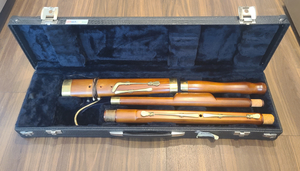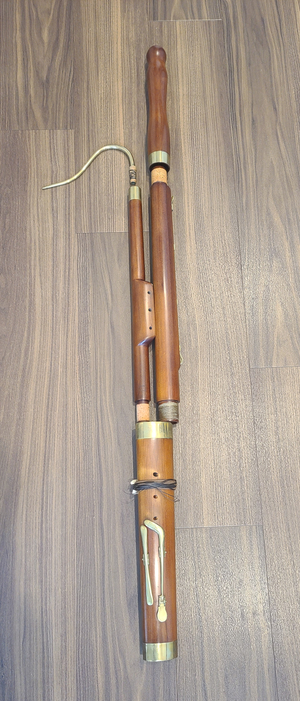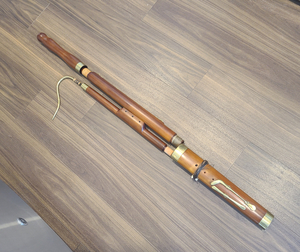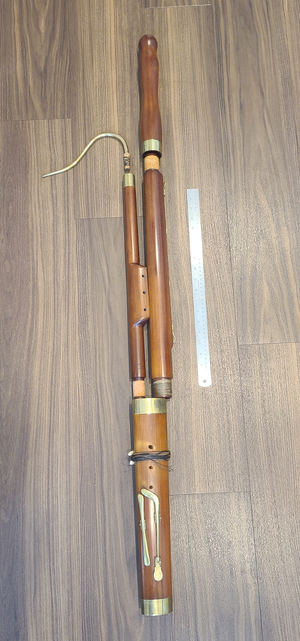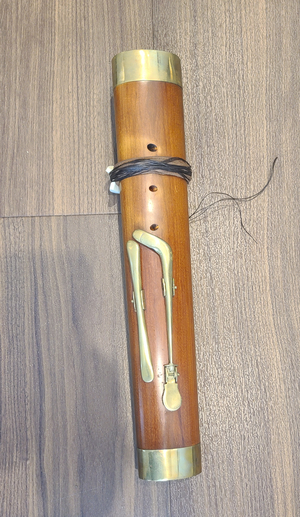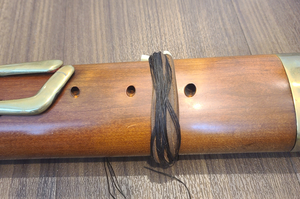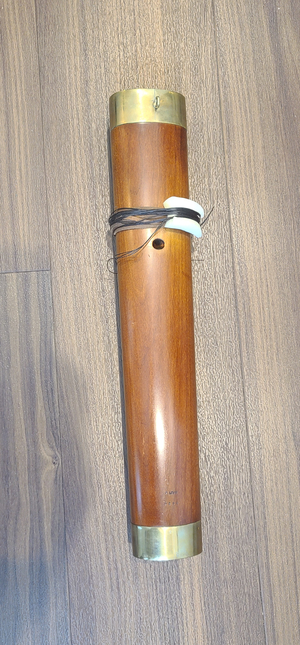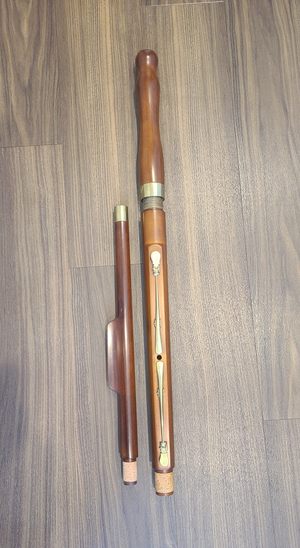
Baltimore Recorders.org
About the Baroque Bassoon
The baroque bassoon is a double reed instrument and plays in the bass range. It has a wide dynamic range, that allows it to play with both loud instruments such as the shawm, and quiet ones such as recorders. It is also notable for its large compass of pitches which can exceed three octaves on a good instrument with a good reed, and skilled performer. This is larger than older instruments such as the dulcian. In practice the range is from B flat 1 (two octaves and a note below middle C) through A in the octave of middle c.
The baroque bassoon is approximately 4 feet 5 inches in length. It is constructed from five sections as seen in the following image:
It has a brass bocal. The bore runs down the body of the instrument, makes a u turn, and then runs up to the bell. It is conical, and expands from the narrow bocal through the bell. The wooden sections are traditionally made from hardwood such as maple or boxwood.
Baroque bassoons typically have 4 keys. Some had as many as 6, and some had as few as three. If the fingerholes were placed orthogonally to the bore, they would be too far apart to reach. Thus, they are drilled at an angle. This effects the tone and loudness of the notes and gives the different pitches on instruments such as this a unique character.
The bassoon as we know it came into existence in the Baroque era. It has been hypothesized that it was invented by Jacques-Martin Hotteterre (29 September 1674 – 16 July 1763), as he is credited for improvements in the bore of the flute, and dividing its body into further sections. No bassoons made by Hotterre have survived. Instruments by some of his luminary contemporaries are extant. These include ones by Johann Christoph Denner, Joannes Hyacinthus Rottenburgh, and Richard Haka. The instruments by Johann Scherer II, and by Johann H. Eichentopf are the most copied by modern makers.
The term bassoon comes from the french word basson. In Spain it was known as the bajon. These in turn were derived from the Italian Bassone, basso and suffix 'one'. The former implies its low range. The latter indicates that it is big (large in size or extra low in range), as opposed to the suffix 'ino' meaning small.
Although the French term has an Italian origin, the Italians used another term for the instrument; fagotto. Again, the suffix otto meaning large. In Germany it was known as a fagott, and in Spain fagot. It is notable that in Germany and Italy, fagotto/fagott were the terms used for the dulcian. This provides a strong link between the instruments. They may have served similar musical roles. They certainly had similar sounds.
The French word fagot was used in the 13th century to refer to a bundle of sticks. Related terms include fagald, faggald, and faget. These also came from an Italian term, fagotto. It in turn comes from the Vulgar Latin facus. Etymologists believe this is derived from fasces (plural of fascis) in Latin, or the Greek term φάκελος (phakelos) meaning bundle.
A fasces were a bundle of wooden rods wrapped around a pole with the blade of an axe projecting from the bundle or at the top of the pole. They were carried by a superior Roman magistrate, known as a lictor. One of the roles of the magistrate was to impose punishments. The sticks in a fasces represent punishment by whipping and the axe represent punishment by execution. The term fasces came to mean high office or supreme power. It is remarkable that fagotto was also associated with execution, burning at the stake.
Despite all of this connection to bundles, many linguists and music historian do not think fagotto, meaning bassoon, is related to bundles. Rather, they believe its meaning may be related to the English usage of the term faget, which could be used to refer to firewood. It may also refer to its use as a unit of measure. It referred to a bundle of sticks that were three feet in length. (A significant point against this view is that such bundles were two feet in girth, and the girth was an important part of the measure.) A long faggot was a bundle that is longer than three feet.
Syntagma Musica plate X describes what we identify as dulcians as fagott. The page also illustrates a sorduen-bas and racketts. It also mentions a doppel fagott, which is smaller than a bass sordun.
Pictured on this page is a baroque bassoon made by P. Levin.
Web design copyright 2015 Michael Berger
